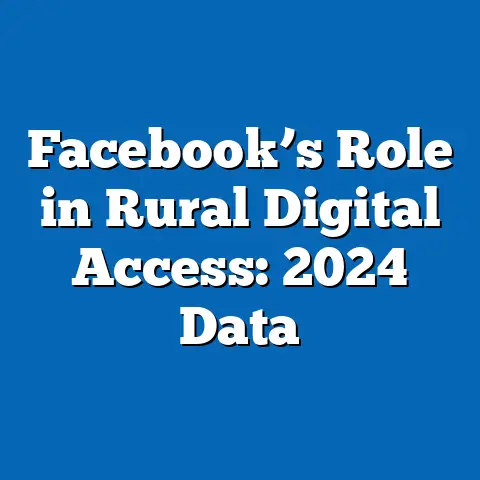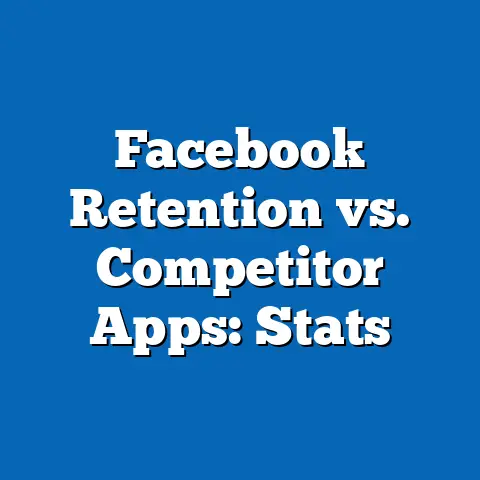Mobile Growth vs. Facebook Server Scale
In the ever-evolving landscape of digital technology, mobile growth continues to outpace traditional platforms, with a staggering 5.3 billion unique mobile phone users worldwide as of 2023, according to Statista. This represents nearly 67% of the global population, a clear indicator of mobile’s dominance as the primary access point for internet services. Meanwhile, Meta’s Facebook, one of the largest social media platforms, reported 3.05 billion monthly active users in Q3 2023 (Meta Investor Relations), supported by an immense server infrastructure that processes billions of interactions daily.
These figures highlight a quick win for mobile growth in terms of sheer reach and accessibility, particularly among younger demographics aged 18-34, who account for over 60% of mobile internet usage (Pew Research Center, 2023). As we head into 2024, understanding the dynamics of mobile growth versus the scalability of platforms like Facebook’s server infrastructure offers critical insights into the future of digital ecosystems. This article will explore these two forces, comparing their trajectories, challenges, and implications for users and businesses alike.
Section 1: Mobile Growth in 2024 – A Global Phenomenon
1.1 Current State of Mobile Penetration
Mobile technology has transformed how people connect, work, and consume content, with penetration rates reaching unprecedented levels. As of early 2023, the global mobile internet user base grew to 4.9 billion, representing 61% of the world’s population, per DataReportal’s Digital 2023 Global Overview. Forecasts for 2024 suggest this number could climb to 5.1 billion, driven by affordable smartphones and expanding 5G networks.
This growth is not uniform across regions. Sub-Saharan Africa, for instance, saw a 12% year-over-year increase in mobile subscriptions in 2022, with projections for 2024 estimating a rise to 900 million users (GSMA Mobile Economy Report 2023). In contrast, mature markets like North America and Western Europe are nearing saturation, with over 85% penetration rates.
1.2 Demographic Patterns in Mobile Usage
Demographic trends reveal stark differences in mobile adoption. Younger users, particularly Gen Z and Millennials (ages 18-34), dominate mobile internet usage, spending an average of 4.2 hours daily on their devices, according to a 2023 survey by App Annie. In contrast, users aged 55 and older spend just 1.8 hours daily, often prioritizing voice calls over data-intensive apps.
Gender differences also play a role. While global mobile ownership is nearly equal (52% male, 48% female), men are 15% more likely to use mobile internet for professional purposes, per the GSMA Gender Gap Report 2023. Women, particularly in developing regions, face barriers like affordability and digital literacy, though initiatives to close this gap are gaining traction.
1.3 Historical Trends vs. 2024 Projections
Historically, mobile growth has been explosive since the introduction of smartphones in the late 2000s. From just 1 billion mobile internet users in 2010, the figure has quintupled by 2023. The rollout of 5G technology is expected to accelerate this trend in 2024, with Ericsson predicting that 5G subscriptions will reach 1.9 billion globally by year-end, up from 1.2 billion in 2023.
Compared to a decade ago, mobile data consumption has also skyrocketed. In 2013, the average user consumed 0.5 GB of data monthly; by 2023, this surged to 11.4 GB, and Cisco projects an increase to 15 GB by 2024 due to streaming and gaming demands. This historical trajectory underscores mobile’s role as the backbone of digital connectivity.
1.4 Data Visualization Description
Imagine a line graph depicting mobile user growth from 2010 to 2024, with a steep upward curve reflecting the rapid rise from 1 billion to a projected 5.1 billion users. A second line, showing data consumption per user, mirrors this ascent, jumping from 0.5 GB to 15 GB over the same period. Regional bars overlaid on the graph highlight disparities, with Africa’s growth curve steepening post-2020, while North America’s flattens due to saturation.
Section 2: Facebook Server Scale – Powering a Social Giant
2.1 The Infrastructure Behind Facebook
Facebook, under Meta’s umbrella, operates one of the largest server infrastructures in the world to support its 3.05 billion monthly active users as of Q3 2023 (Meta Investor Relations). While exact server counts are proprietary, industry estimates suggest Meta manages over 100,000 servers across its 18 data centers worldwide, with plans to expand to 25 by 2025 (Data Center Knowledge, 2023). These facilities handle over 300 billion pieces of content shared daily, including posts, photos, and videos.
The energy demands are staggering. Meta reported consuming 7.2 terawatt-hours of electricity in 2022 for its data centers, equivalent to powering 700,000 U.S. homes for a year (Meta Sustainability Report 2023). To mitigate environmental impact, 100% of this energy comes from renewable sources as of 2023, a benchmark for tech giants.
2.2 Scalability Challenges and Innovations
Scaling server infrastructure to meet user demand is a constant challenge. During peak usage, such as major global events, Facebook experiences traffic spikes of up to 40%, requiring dynamic load balancing across servers (Cloudflare Insights, 2023). Meta’s adoption of AI-driven resource allocation has reduced downtime by 30% since 2020, ensuring seamless user experiences.
Looking to 2024, Meta plans to integrate more edge computing solutions, bringing data processing closer to users. This could cut latency by 20%, per industry projections from Gartner (2023), and support real-time features like live streaming and augmented reality on platforms like Facebook and Instagram.
2.3 Historical Server Growth vs. 2024 Outlook
When Facebook launched in 2004, it operated on a handful of servers in a Harvard dorm room. By 2012, with 1 billion users, it had scaled to tens of thousands of servers. Today, with user growth slowing in mature markets (only 2% year-over-year increase in North America in 2023), server expansion focuses on efficiency rather than raw numbers.
For 2024, Meta’s server strategy will likely prioritize sustainability and AI optimization over massive physical growth. Analysts predict a 15% increase in server capacity through hardware upgrades rather than new data centers, reflecting a shift toward smarter scaling (TechCrunch, 2023).
2.4 Data Visualization Description
Envision a bar chart comparing Facebook’s server infrastructure milestones: from a single server in 2004 to an estimated 100,000+ in 2023. Overlay a line showing user growth, peaking at 3.05 billion in 2023 but flattening in 2024. A secondary axis highlights energy consumption, rising to 7.2 terawatt-hours by 2022, with a green tint indicating renewable energy adoption since 2020.
Section 3: Comparative Analysis – Mobile Growth vs. Facebook Servers
3.1 Reach and Accessibility
Mobile growth clearly outstrips Facebook’s user base in terms of raw numbers. With 5.3 billion mobile users versus 3.05 billion Facebook users, mobile technology offers broader access, especially in regions with limited desktop infrastructure. For instance, in India, 90% of internet users access the web via mobile devices, and 700 million of them use Facebook (DataReportal, 2023).
However, Facebook’s server scale ensures that its platform remains accessible to its user base with minimal downtime. Mobile growth, while widespread, faces challenges like network coverage gaps, with 10% of rural populations in developing nations still offline (ITU, 2023). Thus, while mobile wins on reach, Facebook’s infrastructure provides unmatched reliability for its ecosystem.
3.2 Demographic Overlap and Differences
Both mobile growth and Facebook usage skew toward younger demographics. About 65% of Facebook’s users are under 35, aligning closely with mobile usage patterns (Statista, 2023). However, mobile adoption spans a wider socioeconomic range, including low-income users who may not engage with social media due to data costs or literacy barriers.
Regionally, Facebook’s penetration is highest in North America (80% of internet users) and lowest in Africa (30%), mirroring mobile internet access disparities. In 2024, mobile growth in Africa could further outpace Facebook’s user acquisition as affordable devices proliferate, per GSMA projections.
3.3 Technological Dependencies
Mobile growth and Facebook’s server scale are interdependent. Smartphones rely on robust server infrastructures to deliver apps like Facebook, while Meta’s servers depend on mobile users for traffic—over 98% of Facebook’s access comes via mobile devices (Meta Q3 2023 Report). A disruption in either ecosystem, such as a server outage or mobile network failure, directly impacts the other.
In 2024, this symbiosis will deepen with 5G’s rollout, enabling faster data transfer to and from Facebook’s servers. However, server scalability must keep pace with mobile data demands, projected to grow by 30% annually (Cisco, 2023), to prevent bottlenecks.
3.4 Historical vs. Future Trends
Historically, mobile growth has consistently outpaced individual platforms like Facebook. From 2010 to 2020, mobile users grew at a compound annual growth rate (CAGR) of 18%, while Facebook’s user base grew at 12% (Statista historical data). By 2024, mobile growth is expected to slow to a CAGR of 3-4% due to saturation, while Facebook’s user growth may stagnate at 1-2% as it focuses on engagement over acquisition.
Server scale, historically tied to user numbers, now prioritizes efficiency. While mobile hardware advances (e.g., 5G chips) drive user adoption, Facebook’s server innovations (e.g., AI optimization) aim to enhance user experience without proportional infrastructure growth.
Section 4: Challenges and Opportunities in 2024
4.1 Mobile Growth Challenges
Despite its dominance, mobile growth faces hurdles. Affordability remains a barrier, with 1.4 billion people worldwide unable to access mobile internet due to cost, per the World Bank (2023). Additionally, cybersecurity risks are rising, with mobile malware attacks increasing by 25% in 2022 (Kaspersky, 2023), a trend likely to persist into 2024.
Opportunities lie in emerging markets and technologies. Africa and Southeast Asia are poised for double-digit mobile growth, while innovations like foldable phones and satellite internet (e.g., Starlink) could bridge access gaps by 2024.
4.2 Facebook Server Scale Challenges
For Meta, server scalability faces environmental and financial pressures. While renewable energy adoption mitigates carbon footprints, the cost of maintaining and upgrading data centers is projected to rise by 10% in 2024 due to inflation and supply chain issues (Forbes, 2023). Regulatory scrutiny over data privacy also complicates server operations, with potential fines impacting budgets.
Opportunities include leveraging AI to reduce operational costs by up to 20% (Gartner, 2023) and expanding edge computing to support emerging markets with growing mobile access. Partnerships with mobile carriers could further optimize data delivery.
Section 5: Broader Implications and Future Trends
5.1 Economic and Social Impact
Mobile growth drives economic inclusion, with mobile money services like M-Pesa facilitating $300 billion in transactions annually across Africa (GSMA, 2023). In 2024, this could expand further, empowering unbanked populations. However, it risks widening digital divides if access remains unequal.
Facebook’s server scale, while less directly tied to economic transactions, shapes social connectivity and advertising markets. With ad revenue of $114 billion in 2022 (Meta Annual Report), its infrastructure supports a digital economy that influences consumer behavior globally. In 2024, enhanced server capabilities could deepen personalized advertising, raising privacy concerns.
5.2 Technological Convergence
Looking ahead, mobile growth and server scale will increasingly converge. The rise of the metaverse, championed by Meta, will demand unprecedented mobile and server synergy, with data consumption potentially doubling by 2025 (Ericsson, 2023). In 2024, this trend will manifest in augmented reality apps straining both mobile networks and server capacities.
5.3 Policy and Regulation
Governments worldwide are scrutinizing both ecosystems. Mobile growth faces calls for universal access policies, while server operations encounter data localization laws, with 62 countries enforcing such mandates by 2023 (UNCTAD). In 2024, compliance costs could reshape investment priorities for both sectors.
Conclusion: Navigating a Connected Future
As we move into 2024, mobile growth and Facebook’s server scale represent two pillars of the digital age, each with unique strengths and challenges. Mobile technology’s expansive reach, projected to hit 5.1 billion internet users, offers unparalleled access but struggles with equity and security. Facebook’s server infrastructure, supporting 3.05 billion users with cutting-edge scalability, ensures reliability but faces sustainability and regulatory pressures.
Together, these forces will shape how we connect, work, and innovate in the coming years. The broader implication is clear: balancing growth with responsibility—whether through accessible mobile networks or ethical server practices—will define the digital landscape. As 5G, AI, and the metaverse converge, 2024 will be a pivotal year in determining whether this balance can be achieved.






